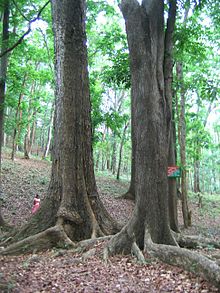
Mahogany
Mahogany is any of many different kinds of tropical hardwood, most of which are reddish-brown wood that is widely used in furniture-making, boat building, and other high specification uses. However, there are only three species of true mahogany, all indigenous to the Americas. These are Swietenia mahagoni (L.) Jacq., S. macrophylla King, and S. humilis Zucc.
The natural distribution of these species within the Americas is geographically distinct. S. mahagoni grows on the West Indian islands as far north as the Bahamas, the Florida Keys and parts of Florida; S. humilis grows in the dry regions of the Pacific coast of Central America from south-western Mexico to Costa Rica; S. macrophylla grows in Central America from Yucatan southwards and into South America, extending as far as Peru, Bolivia and extreme western Brazil.[1] In the 20th century various botanists attempted to further to define S. macrophylla in South America as a new species, such as S. candollei Pittier and S. tessmannii Harms., but many authorities consider these spurious. According to Record and Hess, all of the mahogany of continental North and South America can be considered as one botanical species, Swietenia macrophylla King.[2]
The name mahogany was initially associated only with those islands in the West Indies under British control (French colonists used the term acajou, while in the Spanish territories it was called caoba). The origin of the name is uncertain, but it could be a corruption of 'm'oganwo', the name used by the Yoruba and Ibo people of West Africa to described trees of the genus Khaya, which is closely related to Swietenia. When transported to Jamaica as slaves, they gave the same name to the similar trees they saw there.[3]
Though this interpretation has been disputed, no one has suggested a more plausible origin.[4] The indigenous Arawak name for the tree is not known. In 1671 the word mahogany appeared in print for the first time, in John Ogilby's America.[5] Among botanists and naturalists, however, the tree was considered a type of cedar, and in 1759 was classified by Carl Linnaeus (1707–1778) as Cedrela mahagoni. The following year it was assigned to a new genus by Nicholas Joseph Jacquin (1727–1817), and named Swietenia mahagoni.




